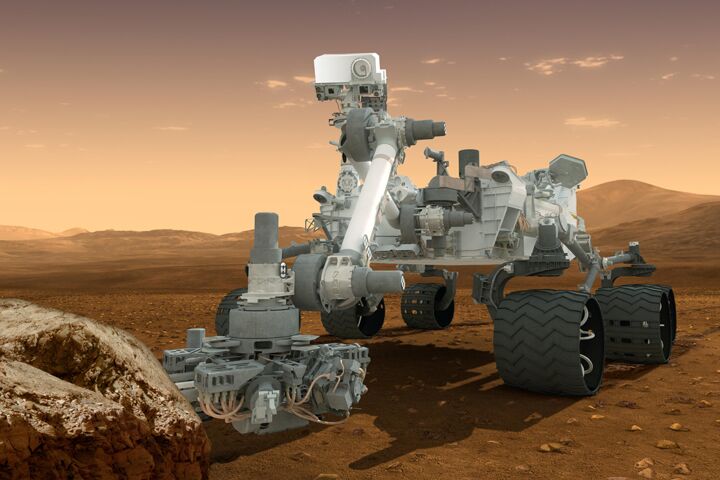
NASA’s Mars Rover Is Awesome
Nasa just landed a small nuclear-powered robot car with a rock-zapping laser on the surface of another planet using a sky crane. And no, that’s not science fiction. Nor have you accidentally slipped into the distant future. It did it last weekend.
What it did was magnificent—sending Curiosity, the Mars Science Laboratory, to the red planet must be one of mankind’s greatest ever technical achievements. The mission is a testament to the incredible strength and ability of the human mind.
To get a sense of how awesome this is, watch this five-minute video on the landing.
First, to get to Mars, Curiosity traveled 354 million miles. That’s the equivalent of driving around the Earth’s equator over 14,000 times. Once it arrived, it was traveling at 13,000 mph—fast enough to fly from London to New York in just over 15 minutes.
To land safely, Curiosity had to go from 13,000 mph to 0 mph in just seven minutes without damaging any of the scientific equipment it carried. Radio signals from Curiosity take 14 minutes to reach Earth, so the landing had to be completely automated—with no human involvement.
As the spacecraft entered the atmosphere, the vehicle’s heat shield was projected to reach 3,800 degrees Fahrenheit (2,100 degrees Celsius).
The atmosphere was expected to slow the rover down to “only” 1,000 mph. Then the craft deployed its parachute—or “super-chute,” as nasa calls it. As the rover yanked on the chute’s rope, the 50-foot-wide parachute would have been hit with around 65,000 pounds of force.
Then things get really cool. The parachute only slows Curiosity down to 200 mph. Explosive bolts release the chute, and then eight rockets come to life.
The craft dodges the newly released parachute, and the descent slows further.
But the rover cannot land using the rockets. The dust cloud they would send up could damage its instruments.
Instead, a sky crane floats above the ground, held up by only the rockets, and lowers Curiosity onto the Martian surface.
The whole time, the rover was being guided so that it landed in a target area 15.5 miles long and 12.4 miles wide.
Oh, and the whole mission was perfectly timed so that the Mars Reconnaissance Orbiter, which reached the planet six years ago, was overhead to take a picture.
If the camera “took the image one second before or one second after, we probably would be looking at an empty Martian landscape,” said Sarah Milkovich, one of the scientists behind the picture. “When you consider that we have been working on this sequence since March and had to upload commands to the spacecraft about 72 hours prior to the image being taken, you begin to realize how challenging this picture was to obtain.”
Former Star Trek actor Wil Wheaton, who narrated the rover’s landing, wrote: “Gene Roddenberry always talked about how amazing humans were, because we could do amazing things when we worked together. He was right.”
And he is. Scientists around the world did something truly incredible.
But if humanity’s best minds can do all this—solve the thousands of technical problems that made the landing possible—why are there so many problems we can’t solve? Why is there still poverty? Why war? Surely solving these problems can’t be much more complicated than sending a laser that can vaporize rock to another planet?
Actually it is.
Man “is limited in knowledge to that which may be transmitted into the brain through the physical senses of sight, hearing, tasting, smelling and feeling,” wrote Herbert W. Armstrong, editor in chief of the Trumpet’s predecessor, the Plain Truth. “Man’s most serious problems are spiritual in nature. But man is naturally confined to thinking solely in terms of the physical and material. He cannot grasp or comprehend spiritual problems or spiritual knowledge.”
That’s why we solve the most complicated physical problems, but we cannot bring peace.
The Trumpet’s editor in chief, Gerald Flurry, said that on a physical level man has “a God-type mind.” There is huge potential in that mind! Mr. Armstrong wrote that the “human mind’s capacity for material accomplishment seems unlimited.” As God looked down on mankind working together at the tower of Babel, He said, “nothing will be restrained from them, which they have imagined to do.” God agrees with Gene Roddenberry—humans can do amazing things when they work together.
But God had to divide mankind at Babel, because all of man’s accomplishments have only brought him closer to his own destruction. Without that vital spiritual dimension of knowledge, man cannot bring peace or solve the massive famines and epidemics that wrack the Earth. Amazing physical accomplishments without spiritual understanding just means that man fights more wars with more and more destructive weapons.
But this will change! God promises that He will give this missing spiritual component to men all over the Earth in the very near future. First, man will need to learn just how deficient his mind is cut off from God. But after that, God says that “the earth shall be full of the knowledge of the Lord, as the waters cover the sea.”
When mankind is willing to listen, God will show the world the way to peace. He will give them the spiritual answers to their problems.
When this spiritual component is added to man’s mind, just think what mankind will be able to accomplish. If the entire planet worked together, using all of humanity’s God-type minds in harmony, mankind would be able to do things that would make the Mars rover landing seem like child’s play.
Once mankind learns to rely on God for this spiritual knowledge, and God adds the missing spiritual component to man’s mind, his potential will reach well beyond Mars and out into the universe.
For more information on this missing spiritual part of man’s mind, and his amazing future with God, read our free book The Incredible Human Potential.
